Getting started carp fishing means lots of new gear. Carp are NOT bass. These fish will destroy your bass setup fairly easily. So here is everything you need to land your first carp.
So you want to start carp fishing?
How many times have we walked into our local well stocked fishing tackle shop and seen before us a huge array of fishing tackle designed to meet every anglers needs. Then we get lost deciding what’s the correct tackle.
Preparation is the key to ensuring you get the right kit for the job without over spending on misguided purchases. The best place to start is to select a venue or two and understand the lake’s features:
– how big is the lake?
– how big are the carp you are hoping to catch ?
– is the lake weedy or snaggy?
All of these key points have a dramatic impact on the type of equipment you will need. Much better to figure things out first than buy a load of tackle and then find out it’s not right for you.
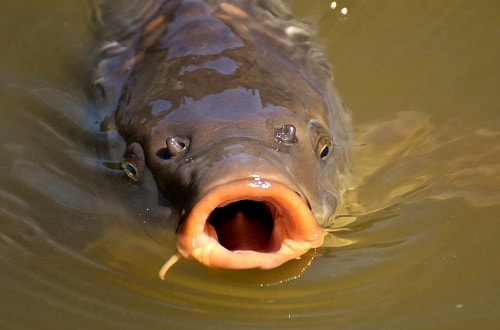
Without doubt there is a lot of very good low priced tackle available on the market. But, like most sports, it is also very easy to spend thousands. You have to beware that there is a lot of tackle that catches unwary anglers rather than catching fish. So, where do we start when we have decided that carp fishing is going to be our hobby from now on? Let’s take a look at some key gear you’re going to need.
RODS
Test curve
Fishing rods, especially carp rods, are often categorized in length and test curve, which to a beginner means nothing.
So what is a test curve?
It is the amount of weight required to bring the tip of the rod to a 90 degree angle while the butt/rod is held horizontally. This measurement provides a guide to the stiffness/power of one rod compared to another.
The test curve on its own is not an indicator of casting capability. The rods action is a better indicator of a rod’s casting potential. For example, a fast-taper 3.0lb test curve rod will have greater casting capability than a through-action 3.5lb test curve rod, but the through-action rod will have other benefits over the faster-action rod.

Actions
For simplicity, only three types of action tend to be referred to:
- Through-action
- Semi-fast
- Fast taper
However, there is a whole spectrum of actions between these, and there are points in the spectrum where the definition of the action is a matter of opinion. For example, some people may describe the same action as either a semi-fast or a through-action. Also semi-fast and fast-taper actions become confused. The result is that the action of a rod described in the angling press is sometimes misleading.
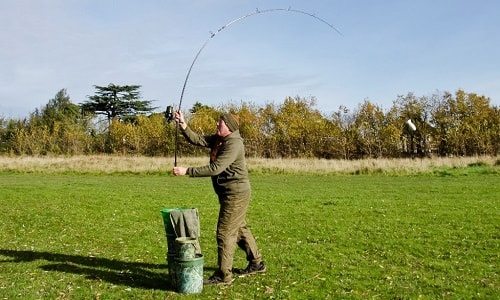
Through-action rods are a dream for playing fish as the rod can be allowed to play the fish without the angler having to continually adjust the clutch or back-wind. Other benefits include:
- Minimizing the chance of hook pulls,
- Allowing the use of lighter breaking strain main lines and hooklink materials,
- Accurately casting at shorter range.
They also perform well when using light leads and smaller hooks. Through-action rods are not a good choice if you are requiring distance casting, fishing with heady method feeders or you are fishing weedy or snaggy waters.
Semi-fast-action rods, also referred to as “medium action,” have a progressive action and are normally a compound-taper or parabolic by nature. Most general carp rods are built to have this action. These rods generally play fish well, and cast small and medium PVA bags and method feeders accurately with ease (dependent on their test curve). They do not require specialist casting techniques to achieve good casts.
Please note semi-fast rods do not cope well with extreme-range, continual long-range or large PVA bags or heavy method feeder work. A semi-fast-action is therefore an all-rounder’s action.
There are many variations on this theme so it is always well worth asking for advice from people who use the rods, internet forums and local tackle shops so seeking knowledgeable advice is important.
Fast-action rods are best for extreme- range or long-range casting, but require a good casting technique to realize their full potential. They are at their best when casting heavier weights such as larger PVA bags or method balls. The action of these rods is often called wooden – or like fishing with a broom stick. Therefore, these are the least enjoyable action with which to hook and play fish. The stiff unforgiving casting biased action creates a greater chance of hook pulls or hooklink breakage, and relies upon the stretch in the main line whilst at range and good clutch control to minimize these problems. Fast-action rods are also difficult to cast accurately at shorter range (under 70 yards) because a little extra effort on the cast results in a lot more distance, generally making it difficult to place a baited rig under an overhanging tree line, for example.
Character
The action and test curve both affect the character of a rod, but there are other factors that influence the feel, balance and recovery rate and therefore change the character. The type of carbon cloth used, the position, number and type of rod guides, the position of the reel seat, the type of handle and other factors can all have an effect.
50mm butt rings – pros & cons
50mm butt rings have become more popular in recent years because they reduce the chance of the line grabbing the butt ring during casting – a problem that is more evident when using reels with large diameter spools. However, the benefit of the 50mm ring needs to be weighed against other considerations:
- they may not fit in your present luggage.
- Because of their size, 50mm rings are more vulnerable, so need care to avoid damage.
Summary – what’s the best carp rod for the job?
A compromise is always needed with fishing tackle and you will always get a lot more fun from the fish you hook and catch if your tackle is well balanced. This table gives you a rough idea of what different rods should be able to achieve:
| Test curve | Casting Weight | Suitable for … |
| 2.25lb | 2.0oz | Small commercial lakes, surface fishing. |
| 2.5lb | 2.5oz | Small lakes with little or no snags. |
| 2.75lb | 3 oz | Small-medium lakes that are slightly snaggy. |
| 3.00lb | 3.5 oz | Medium lakes that are snaggy. |
| 3.25lb | 4 oz | Medium to large lakes that are snaggy, and for casting solid PVA bags or method, Feeders. |
| 3.5lb | 4.5oz | Large lakes that are snaggy, and for casting solid PVA bags or method, Feeders. |
REELS (BIG PITS OR FREE SPOOL)
The majority of angling is undertaken using fixed spool reels. A fixed spool reel is normally controlled by a clutch which may be at the front or at the rear of the reel body. The clutch allows the angler to set the tension at which line can be pulled from the spool with the bale arm engaged. This tension needs to set to prevent breakage of the main line when playing a large fish. The Free spool, often called a baitrunner® which is a Shimano trade mark, is an additional clutch that can be engaged to let line flow freely from the spool with the bale-arm engaged, but with a simple turn of the reel handle or flick of the free spool lever, the normal clutch tension is re-applied to the spool.
What advantage does this give? With the rods in the rests or on alarms, the baitrunner allows line to ‘freespool’ from the reel when a fish picks up the bait and is hooked against the lead or feeder. If the line was unable to release from the spool, then the rod would be pulled into the water or the line would break.
Free spool reels
Carp reels fall into two main categories. The first, and possibly the most popular, is a free spool type reel (most anglers refer to these as baitrunners® – a Shimano trade mark for their easy to use free spool system). Due to the self hooking nature of modern carp rigs, when a carp picks up your bait and is hooked, they normally spook and swim off at great speed. Without a free spool system on your reels your carp rod and reel would be dragged into the lake.
Free spool type reels are available in a whole range of sizes, from small reels suitable for Barbel, Tench or Bream fishing with small capacity spools for 195m 12lb line, through to the biggest which can hold 600m 12lb line.
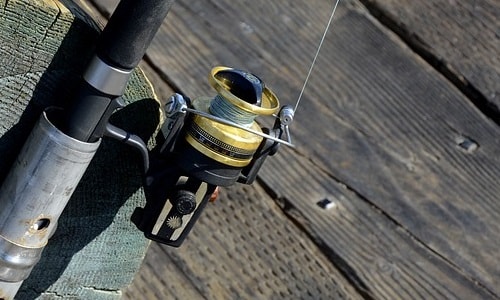
Big pit reels
Big pit reels are designed to carry large quantities of high diameter line which is required when tackling large lakes and reservoirs. The extra diameter line (increased breaking strain) would fill a normal spool quickly and therefore creates a lot of line drag as the line leaves the spool during a cast, this drag will greatly reduce your casting range.
To ensure you have enough line of the right diameter on the spool for the range you are fishing, a large spooled big pit reel is the answer. These reels have slower gearing and longer reel handles, which gives them very powerful retrieve capability. This can be useful when pulling in a ton of weed or that once in a life time huge carp. A front clutch system is the norm on most big pit reels. Some have a standard clutch, which means you have to turn the front drag knob many turns to get the clutch to fully disengage. Others have a quick front clutch which only requires a small 90 degree turn to disengage. The front clutch needs to be loosened after you have cast your rig out into the lake to achieve the free spool you will need if you get a take.
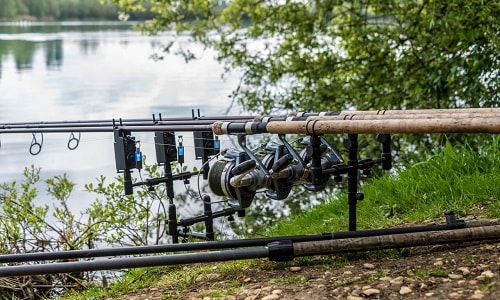
LINE
There are two main types of fishing line available – monofilament and fluorocarbon line. Monofilament line is normally a cheaper line and has a better breaking strain for its given diameter than the same diameter fluorocarbon line.
However, fluorocarbon line has a couple of advantages over monofilament. Due to the make up off fluorocarbon, the line has the same light reflective index as water. This means that it is invisible in water once it is laying on the lake bed. It is also a sinking line, which means it will sit nicely on the bottom of the lake bed out of the way of the carp as they swim near your rigs.
Monofilament line has many properties which can be useful when fishing: abrasion resistance, suppleness, diameter and knot strength, plus the fact it is pre-stretched, coloured, and it floats. And that’s not forgetting the breaking strain. A good value for money line is what most people will be looking for. With this in mind, I would recommend Daiwa sensor, in either dark or clear, depending on you preference. It’s a line that is supple, knots well, and has low diameter with a strong breaking strain.
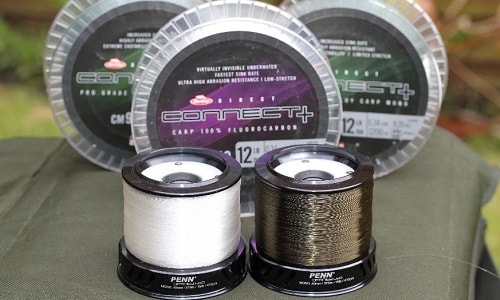
Different venues, different line
If you are fishing clear lakes with few or no snags, 12lb line which has a diameter of .33mm is ideal. However, if your venue is snaggy, or has gravel bars or beds of muscles which can damage your line, then 15lb at .37mm or 18lb at .40mm would be suitable. If you want to spend a little more on your line, Pro Clear by Terry Eustace is a great line that has all the benefits of monofilament (it’s thin, supple, and knots well) but best of all it sinks like a stone.
Fluorocarbon line is generally thicker and more wiry – this can make the line more difficult to cast at range. If you are fishing close in or even at mid range, you won’t experience any problems. A good flouro is P-Line Fluorocarbon, which is remarkably supple and soft for a flouro line. Please note you will normally pay double or triple the amount you pay for the same breaking stain monofilament line.
All credit for these awesome tips goes to Deeper Sonar. https://deepersonar.com/uk/en_gb/blog/essential-gear-carp-fishing-part-1





